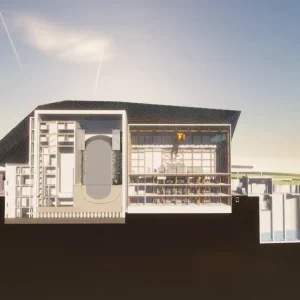Secretary Chu announced the release of DOE’s 2008 wind technologies market report, detailing $16 billion in investment in wind projects made in the US in 2008.
“American families and businesses are struggling in a recession and an increasingly competitive global economy. The Recovery Act was designed to rescue the economy from the immediate dangers it faces while rebuilding its fundamentals, with an eye toward new industry and opportunity,” Secretary Chu said. “To help meet these challenges, the Recovery Act invests significant dollars to put people to work to spur a revolution in clean energy technologies.”
“Wind energy will be a critical factor in achieving the President’s goals for clean energy, while supporting news jobs,” said Secretary Chu. “While the US leads the world in wind energy capacity, we have to continue to support research and development as we expand renewable energy deployment.”
DOE’s new report found that wind power capacity increased by 8,558 megawatts (MW) in 2008. This $16 billion investment in wind projects made the US the fastest-growing wind power market in the world for the fourth consecutive year. Wind power contributed 42% of all new US electric generating capacity in 2008; for the fourth consecutive year, wind power was the second-large new resource added to the US electrical grid in nameplate capacity.
The report, which has been issued annually since 2007, analyzes a range of developments in the wind market, including trends in wind project installations, turbine size, turbine prices, wind project costs, project performance, and wind power prices. The report also details trends in project financing, a key concern for the wind industry in the current economic climate, as well as trends in project ownership, public policy, and the integration of wind power into the electrical grid. DOE’s report provides the wind industry, state and local policy makers, and the general public with valuable information on the state of wind power in the US.
Some of the key findings of the report include:
The US continues to lead the world in annual capacity growth and overtook Germany to take the lead in cumulative wind capacity. For the fourth straight year, the US led the world in wind capacity additions, capturing roughly 30% of the worldwide market.
The cumulative wind capacity installed in the US at the end of 2008 would, in an average year, be able to supply roughly 1.9% of the nation’s electricity consumption.
Soaring demand for wind has spurred expansion of wind turbine manufacturing in the US As a result of this continued expansion, the American Wind Energy Association estimates that the share of domestically manufactured wind turbine components has grown from less than 30% in 2005 to roughly 50% in 2008, and that roughly 8,400 new domestic manufacturing jobs were added in the wind sector in 2008 alone.
Texas led all states with 7,118 MW of total wind capacity installed, followed by Iowa (2791 MW) and California (2517 MW). Seven states now have more than 1,000 MW installed, and 13 have more than 500 MW.
Iowa and Minnesota have the highest levels of wind penetration (in-state wind generation as a percentage of all in-state generation). Seven states have wind penetration levels greater than 5%; six utilities have in excess of 10% wind on their systems.
Wind power remained competitive in wholesale power markets in 2008, with average wind power prices at or below the low end of the wholesale power market price range, although upward pressure on wind power prices looks set to continue.
Award Selections: Supporting Wind Turbine Research and Testing:
Alpha Star Corporation – Advanced Composite Wind Turbine Blade Design Based on Durability & Damage Tolerance (Long Beach, California) – $200,383
Analatom, Inc. – Remote Structural Health Monitoring and Advanced Prognostics of Wind Turbines (Sunnyvale, California) – $200,000
Bayer Material Science, LLC – Carbon Nanotube Reinforced Polyurethane Composites for Wind Turbine Blades (Pittsburgh, Pennsylvania) – $750,000
Board of Regents, Univ of Nebraska-Lincoln – Online Nonintrusive Condition Monitoring and Fault Detection for Wind Turbines (Lincoln, Nebraska) – $380,398
DNV Global Energy Concepts, Inc. – Supporting Wind Turbine Research and Testing – Gearbox Durability Study (Seattle, Washington) – $399,616
Dow Corning Corporation – Lifetime Lubricating Fluid for Gearboxes to Increase Efficiency and Durability of Wind Turbine Drive Trains (Midland, Michingan) – $745,189
General Electric – Wind Turbine Manufacturing Process Monitoring (Niskayuna, New York) – $697,769
Honeywell International, Inc. – Condition Based Monitoring for Wind Farms (Golden Valley, Minnesota) – $626,086
Michigan Aerospace Corporation – Turbine Reliability and Operability Optimization Through the Use of Direct Detection LIDAR (Ann Arbor, Michigan) – $748,002
Native American Technologies Company – Automated Welding, Forming, Coating for On-Site Fabricated, Self-Erecting Utility Scale Wind Towers (Lakewood, Colorado) – $749,739
Northern Power Systems, Inc. – Advanced Manufacturing and Supply Chain Automation (Barre, Vermont) – $683,388
PPG Industries, Inc. – Wind Blade Manufacturing Innovation (Shelby, NC) – $741,754
QM Power, Inc. – Advanced High Power Density Permanent Magnet Wind Generators (Greenwood, Missouri) – $398,005
University of Massachusetts Lowell – Effect of Manufacturing-Induced Defects on Reliability of Composite Wind Turbine Blades (Lowell, Massachusetts) – $499,886
Transmission Analysis, Planning and Assessments:
Areva Federal Services – Best Practices and Advances in Strategies and Decision Support Systems for Integrating Wind Energy for Reliable Grid Operations (Bethesda, Maryland) – $275,610
Bradley Nickell – Balancing Authority Cooperation Concepts to Reduce Variable Generation Integration Costs in the Western Interconnection (Salt Lake City, Utah) – $319,200
Electric Power Research Institute – Integrating Midwest Wind Energy into Southeast Electricity Markets (Knoxville, Tennessee) – $399,135
EnerNex Corporation – Documentation, User Support, and Verification of Wind Turbine and Plant Models (Knoxville, Tennessee) – $749,868
Hawaiian Electric Company – Hawaii Utility Integration Initiatives (H.U.I.) to Enable Wind (Honolulu, Hawaii) – $750,000
Illinois Institute of Technology – WINS: Market Simulation Tool for Facilitating Wind Energy Integration (Chicago, Illinois) – $749,877
Regents of New Mexico State University – Investigating Short Circuit Models for Wind Turbine Generators (Las Cruces, Las Cruces, New Mexico) – $272,816
Regents of the University of Michigan – Techniques for Voltage Control and Transient Stability Assessment (Ann Arbor, Michigan) – $413,534
Tennessee Technological University – Multi-Level Energy Storage and Controls for Large-Scale Wind Energy Integration (Cookeville, Tennessee) – $265,677
The Regents of the University of Colorado – Upstream Measurements of Wind Profiles with Doppler Lidar for Improved Wind Energy Integration (Boulder, Colorado) – $233,082
University of Texas at Austin – Techno-Economic Modeling of the Integration of 20% Wind and Large-scale energy storage in ERCOT by 2030 (Austin, Texas) – $510,688
University of WI-Milwaukee – Lithium-Ion Ultracapacitors integrated with Wind Turbines Power Conversion Systems to Extend Operating Life and Improve Output Power Quality (Milwaukee, Wisconsin) – $422,266
V&R Energy Systems Research, Inc. – Improving Reliability of Transmission Grid to Facilitate Integration of Wind Energy in Tri-State G&T and AECI (Los Angeles, California) – $195,002
WINData, Inc. – Use of Real-Time Off-Site Observations as a Methodology for Increasing Forecast Skill in Prediction of Large Wind Power Ramps One or More Hours Ahead of Their Impact on a Wind Plant (Great Falls, Montana) – $398,966






